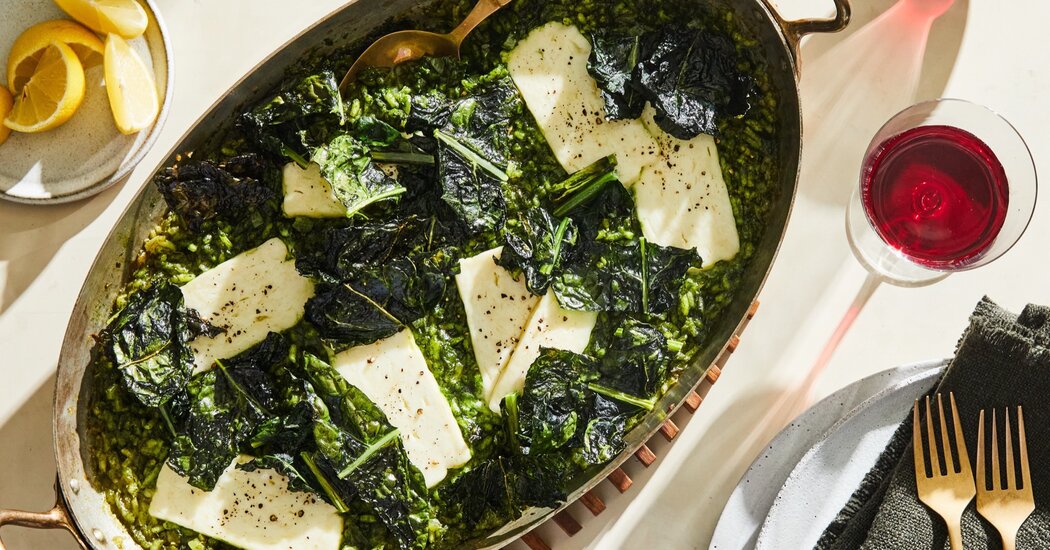Why am I doing this?
The thought hits me as I fold cavolo nero purée into what was, moments ago, perfectly reasonable rice. Dark green ribbons swirl through the pale grains until everything turns a vivid, almost violent green. Am I adding this purée for flavor, or is it for the rich color? The effect is dramatic, but is that enough of a reason?
Recipe: Baked Kale Rice With Halloumi
I am consistently seduced by the most colorful things. At my local vegetable shop, my eye goes first to the brightest peppers, the reddest radishes, the oranges that seem to glow from within. A dish can be perfectly seasoned and beautifully textured, but if it looks dull — all beiges and browns — something in me resists calling it finished.
My kids, when they were a little younger, would look at today’s rice dish with barely concealed horror. Green, for them, would signal all that’s tedious about eating — the lectures, the negotiations, my desperate pleas. What child craves bitter leafy things? Certainly not my own 8-year-old self. But somewhere between then and now, something shifted for me.
Walking through supermarket produce aisles, I now gravitate toward whatever looks most aggressively green. Three types of kale — dinosaur, curly and baby — come home with me, not because I have specific plans for each, but because they look so alive. The evolutionary logic has flipped entirely. The glucosinolates, sulfur-containing compounds found in the likes of kale and broccoli, which once set off my danger signals, now feel like promises of vitality.
When developing recipes, I find myself making choices that balance visual impact with flavor, like my Rosh Hashana brisket this year, where I just had to add a bright element, a honey-mustard-beet sauce, to cover my delicious, yet admittedly dull, slices of slow-cooked meat. When so much of our food comes packaged, processed, drained of its original hues, choosing lively looking ingredients becomes a kind of statement.
A dish can be beautifully textured, but if it looks dull, something in me resists calling it finished.
The research on food-color psychology supports what I feel intuitively. Studies by the noted psychologist Charles Spence show that color is “the single most important product-intrinsic sensory cue” for setting taste expectations, but it also affects our entire relationship with food. Warm colors trigger appetite because they signal ripeness. The Maillard reaction, which turns food an evocative golden brown, makes us want to devour what is simply good for us.
Green tells a more complex story. Unlike the immediate pleasure of golden brown or deep red, green promises rewards that aren’t entirely immediate: the slow release of nutrients, the satisfaction of eating well, the visual pleasure of a plate that looks so alive. It’s the color of transformation itself.
The food writer Ruby Tandoh talks about how social media has understood this science and how colors are used to stop people from scrolling past. As an example, she talks about Mob, a Britain-based cooking site whose super-impactful images she describes as having “the same shades of sunsets, yolks, terra cotta, mahogany, vermilion and tar that you’d find in a New York-style cheese slice.” There’s wisdom in this approach: These colors work because they tap into something fundamental about human appetite.
But it’s also troubling to reduce all food to what performs best on screens. When we prioritize those golden tones that promise instant gratification, we’re essentially cooking for our 8-year-old selves. Adult eating is more layered than that. We lose something essential when we abandon the relationship with ingredients as they exist, not as they photograph.
I’m as susceptible as anyone to being taken in by color, and today’s recipe is proof. But it’s important to make sure those colors are honest. My children, by now, have largely come around to greens. Not because I’ve persuaded them — I’ve learned that never works with food — but because time has a way of shifting these hungers. What once seemed impossible becomes merely unfamiliar, then tolerable, then somehow necessary.
In today’s recipe, I’m not choosing color over flavor; I am using color to find better flavor. The halloumi softens into creamy pockets, the crispy cavolo nero on top provides textural contrast, and that green purée delivers exactly what it promised: earthiness, richness and the particular satisfaction that comes from eating something that looks like it could grow in a garden. The color led me there, but the flavor is what makes me want to cook it again.
Yotam Ottolenghi is a writer and the chef-owner of the Ottolenghi restaurants, Nopi and Rovi, in London. He is an Eat columnist for The New York Times Magazine and writes a weekly column for The Guardian’s Feast Magazine.
The post This Vibrantly Green Rice Is Also a Feast for the Eyes appeared first on New York Times.




